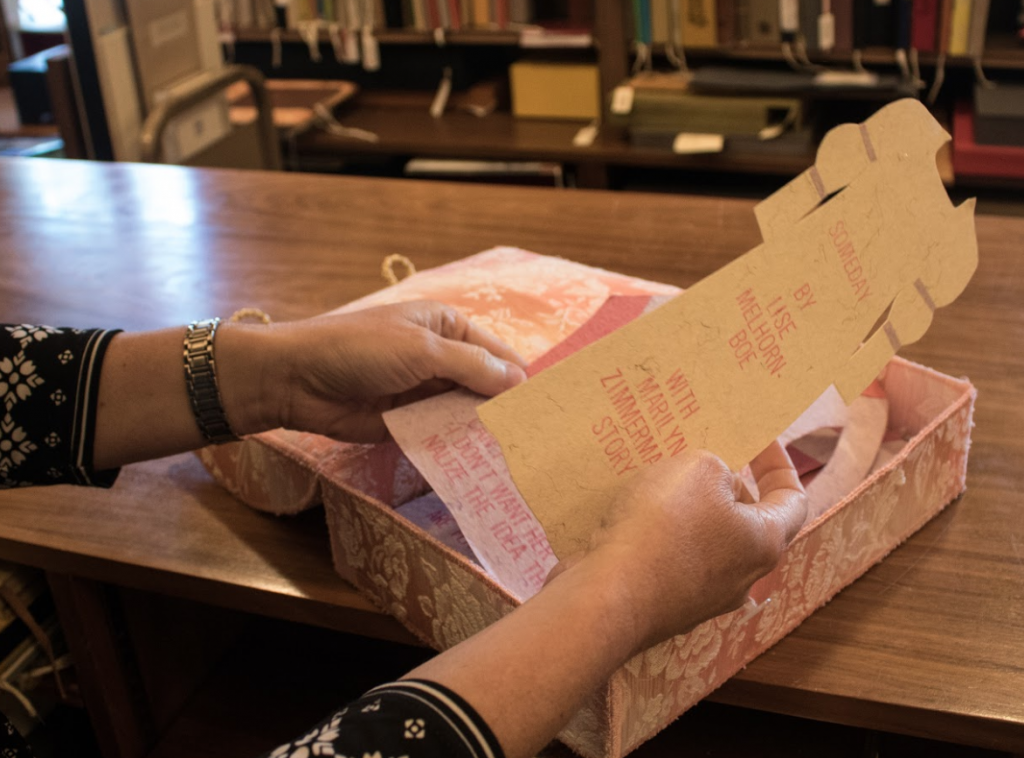Alyssa Leong ‘23
Staff Writer
A 4,000 year old cuneiform tablet that could fit in the palm of a hand. A massive songbook from sixteenth century France painted with richly colored pigments and gold leaf. A book shaped like an early 2000s cell phone whose pages contain the balcony scene from “Romeo and Juliet” translated into texting language. These are just a few of the books available in the Rare Book Room at the Ella Strong Denison Library, whose shelves hold between 40,000 and 50,000 books, according to Denison Director Jennifer Martinez Wormser.
Denison’s large collection of rare books began in Scripps’ founding years with the Treasure Room, an area behind the circulation desk. The collection outgrew this space in the 1940s after the library received a large bequest from John Perkins, a Los Angeles book collector and friend of Scripps librarian Dorothy Drake. Perkins donated thousands of volumes to Denison after his death, some of which he acquired specifically for the library. Both Perkins and Drake collected pieces about rare books and rare materials for Denison’s collection.
In 1966, the rare book collection was reallocated to the room it is in today, which was previously a study space. The room is kept at 60 degrees with low humidity levels to preserve the books.
“[The Rare Book Room is] a really cool space, and cool means a variety of things in this context,” Martinez Wormser said. “It’s cool because it’s fascinating and interesting and it’s also cool because it’s cold.”
The Rare Book Room has continued to collect books since Perkins’ bequest. Along with older manuscripts made from parchment, or animal skin, the collection also contains fine binding books (which have decorative bindings and elaborately designed covers), fore-edge paintings (detailed paintings decorating the edge of pages) and artist’s books, among others.
Artist’s books are an especially broad category, taking up an entire half of the Rare Book Room. These books, which aim to prove a more interactive experience for a reader than a typically bound book, are made by artists who use the traditional format of a book as the medium to deliver their message.
“R and J: The Text Message Edition,” mentioned earlier, is one example of these artist’s books. Another example is “The Red Shoe Reader,” which folds out like an accordion and whose pages are enclosed by half of a red high heel on either board. Inside, it is not unlike a pop-up book, whose interactive panels and dials chronicle the history of women’s footwear throughout different cultures and time periods.
Another artist’s book in Denison’s collection is a treasure box, in which each page is a paper doll, complete with little clothes. The story is about a mother whose daughter wants to play a make-believe game where she is a princess who gets rescued by a prince. The mother, a feminist reflects on this and grapples with how she does not want her daughter to think she has to be saved.
According to Martinez Wormer, the initial donation from Perkins did not include many perspectives from outside of the Western world. She argues that art books in particular offer a way for the collection to include a wider array of viewpoints.
“The artist’s books are special because they engage with the reader in a different way,” Martinez Wormer said. “And I think they reflect the interdisciplinary nature of the Scripps curriculum because they bring together and unify the information in creative and often unanticipated ways, and I think that’s part of the Scripps experience.”
The volumes in the Rare Book Room are available for research. However, they are not browsable like the rest of the Denison library, meaning that they need to be reserved ahead of time.
In order to do that, students can access the online catalog on the Claremont Colleges Library website. If a student wants a book specifically from Scripps (as opposed to the default, which will show results for worldwide libraries), they must select the Denison as the location.
To check out the book, the student must select the box that reads “Get This Item,” which leads to a different software called AEON. After making an AEON account as a researcher, students can request the item.
Alternatively, if a student has a broader research topic or doesn’t know where to start with their research, Martinez Wormer encourages them to ask her for assistance.
“I think one of the important things students develop at their time here is that set of search strategies,” she said. “As we like to say, ‘anyone can search, but not everyone can do research,’ they’re two different things.”
Furthermore, while many different students and classes visit the Rare Book Room for research purposes, she also welcomes visits for fun.
“One of the fun things about being a librarian in a college setting is that we have so many fun opportunities for sharing the materials,” Martinez Wormer said. “Part of the delight for me is being able to share the materials with other people, and it also gives me an excuse to discover some new items that maybe I haven’t seen before.”
10/30, Volume XXIX, Issue 3



